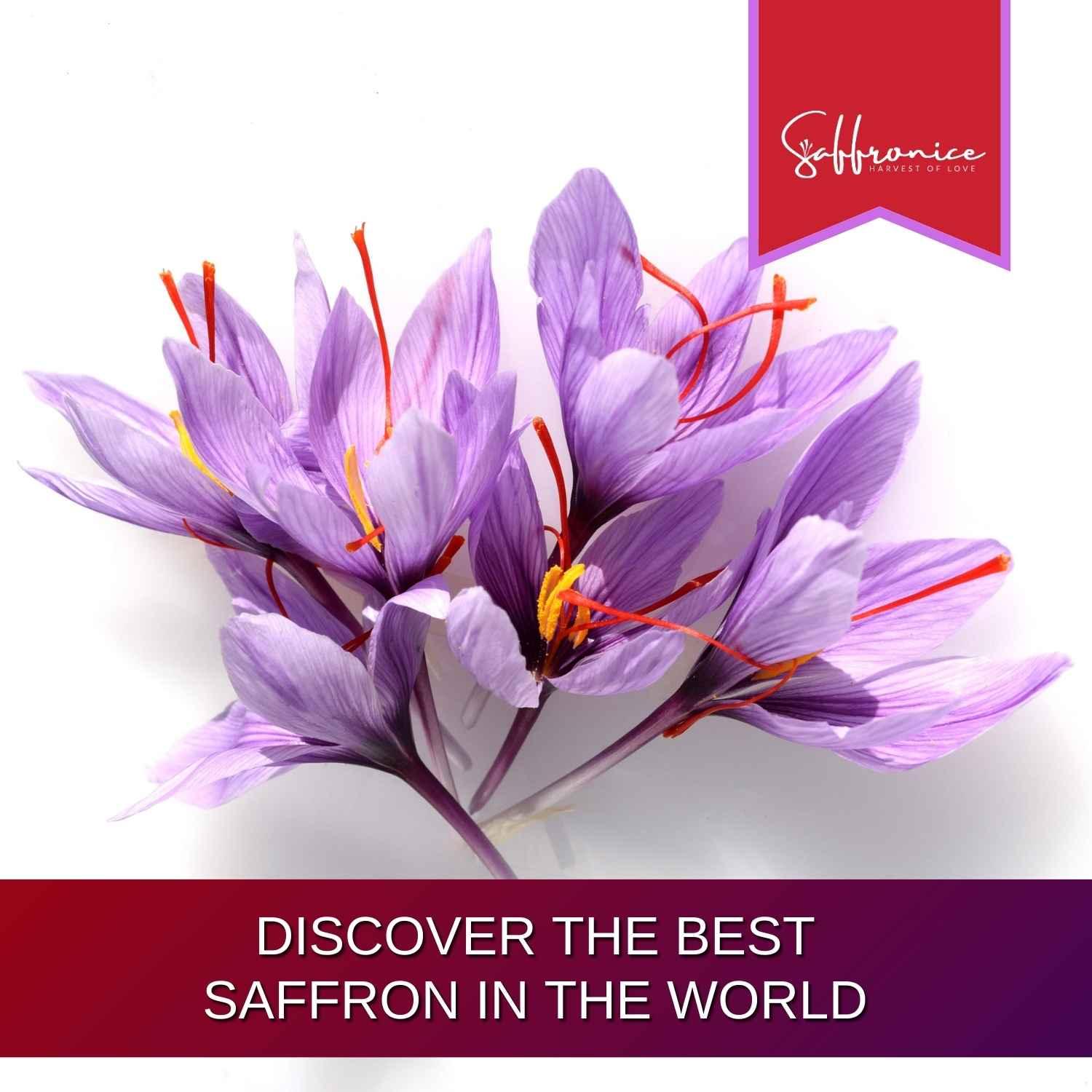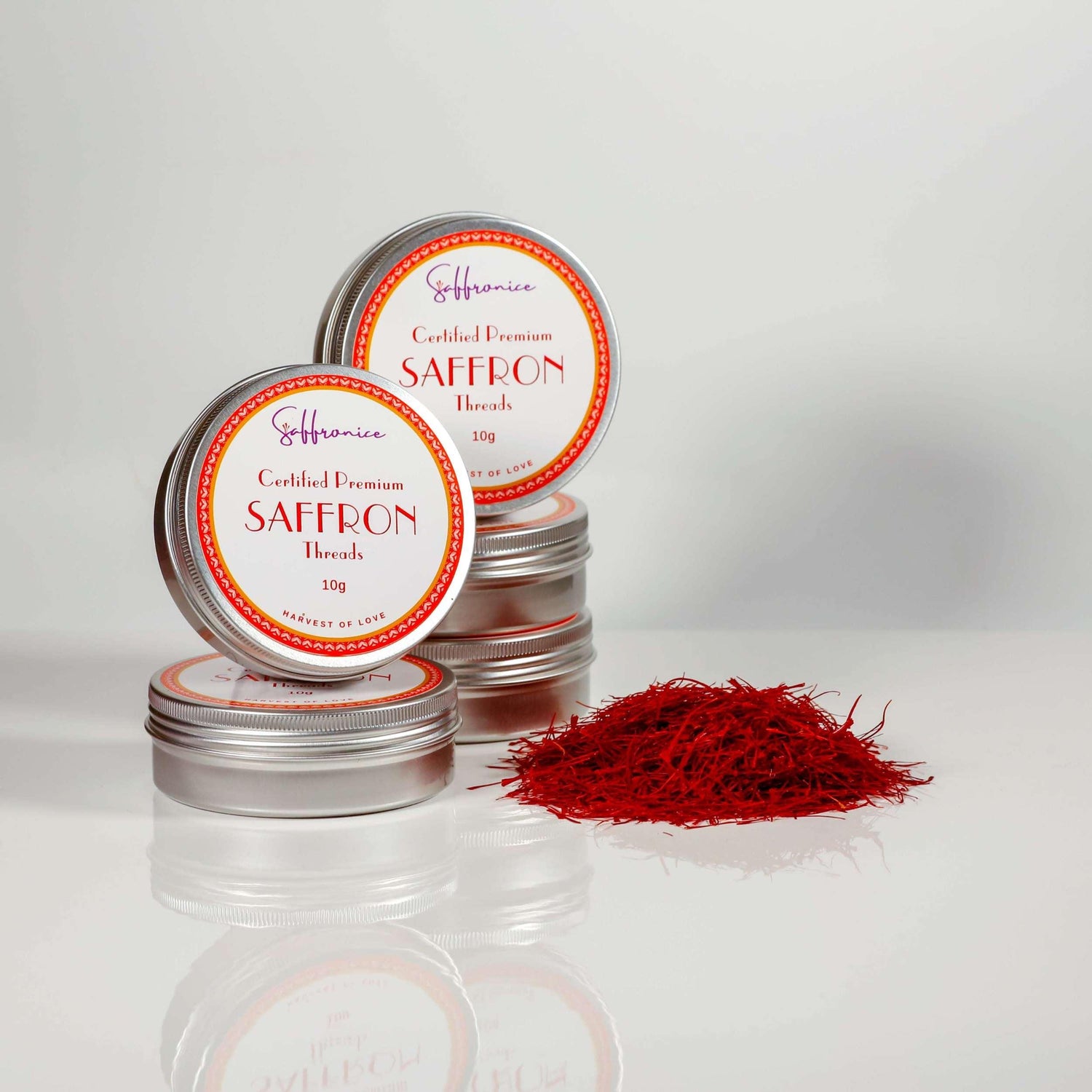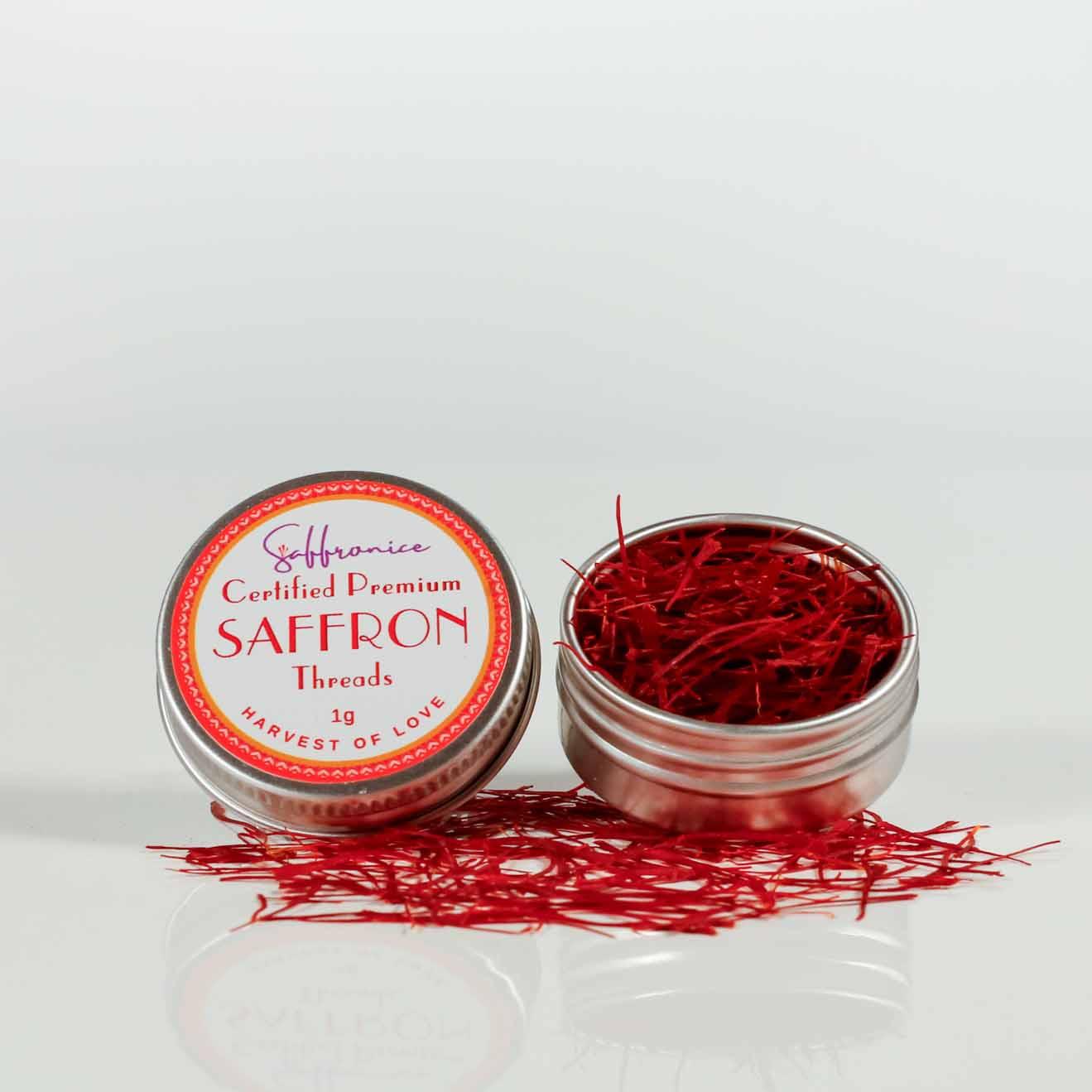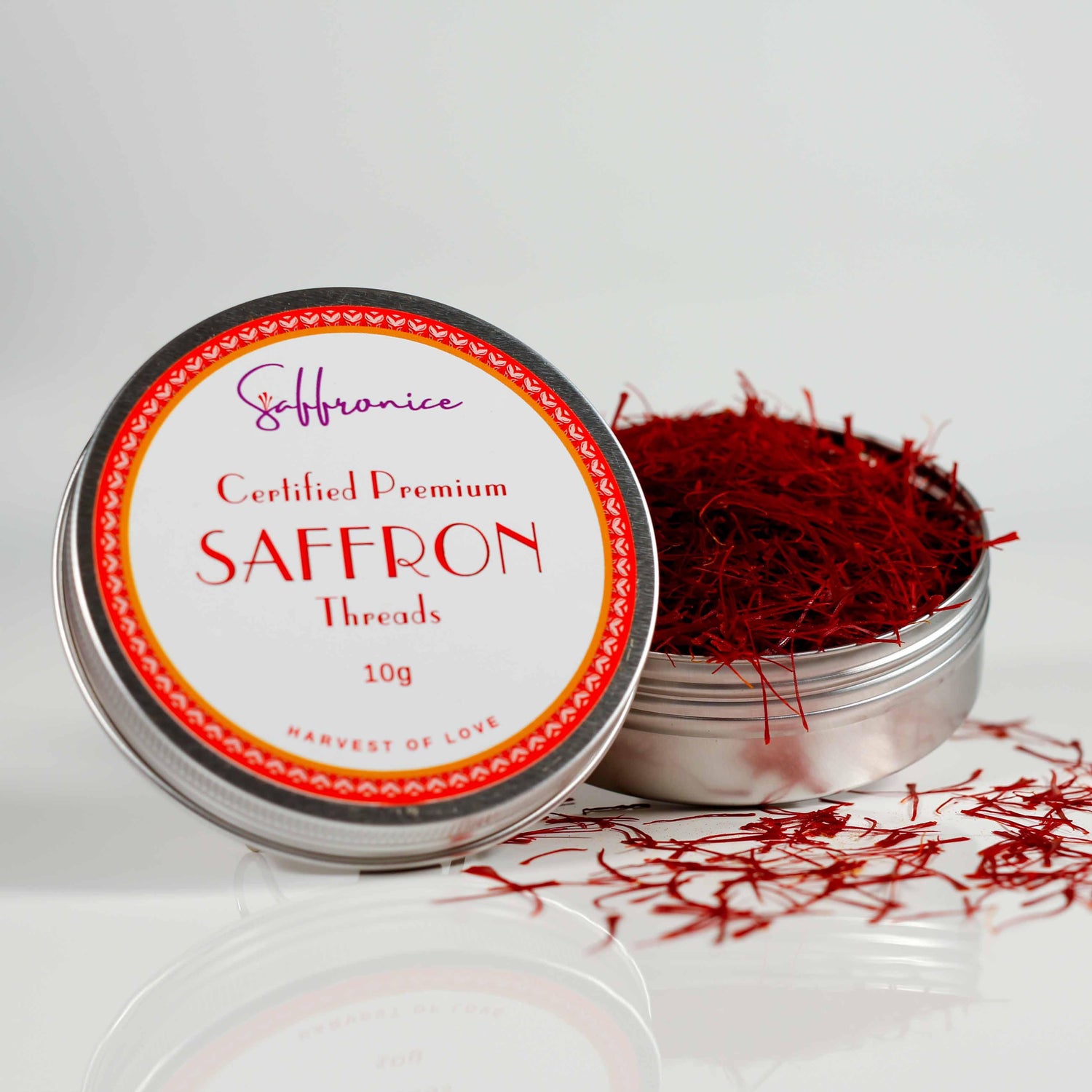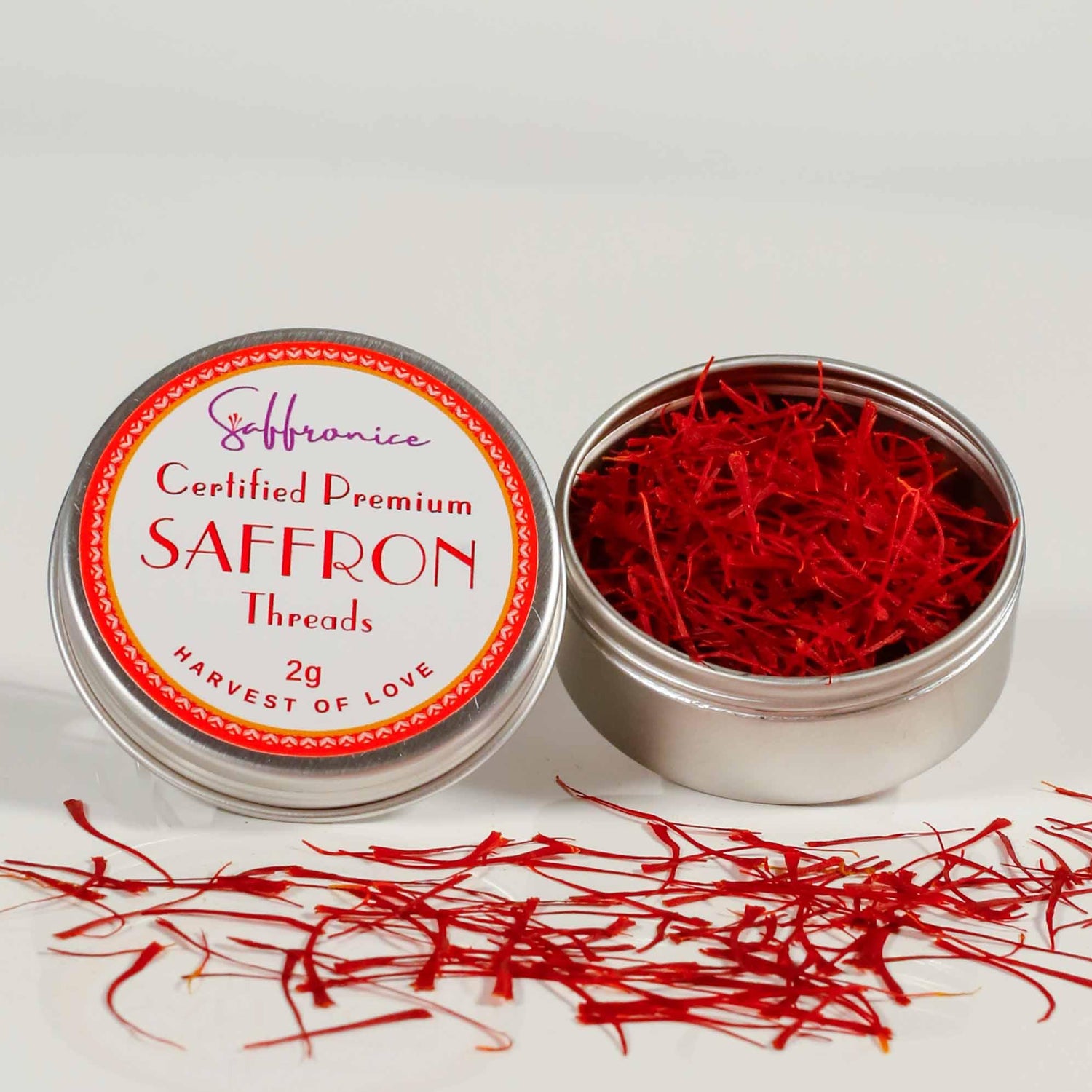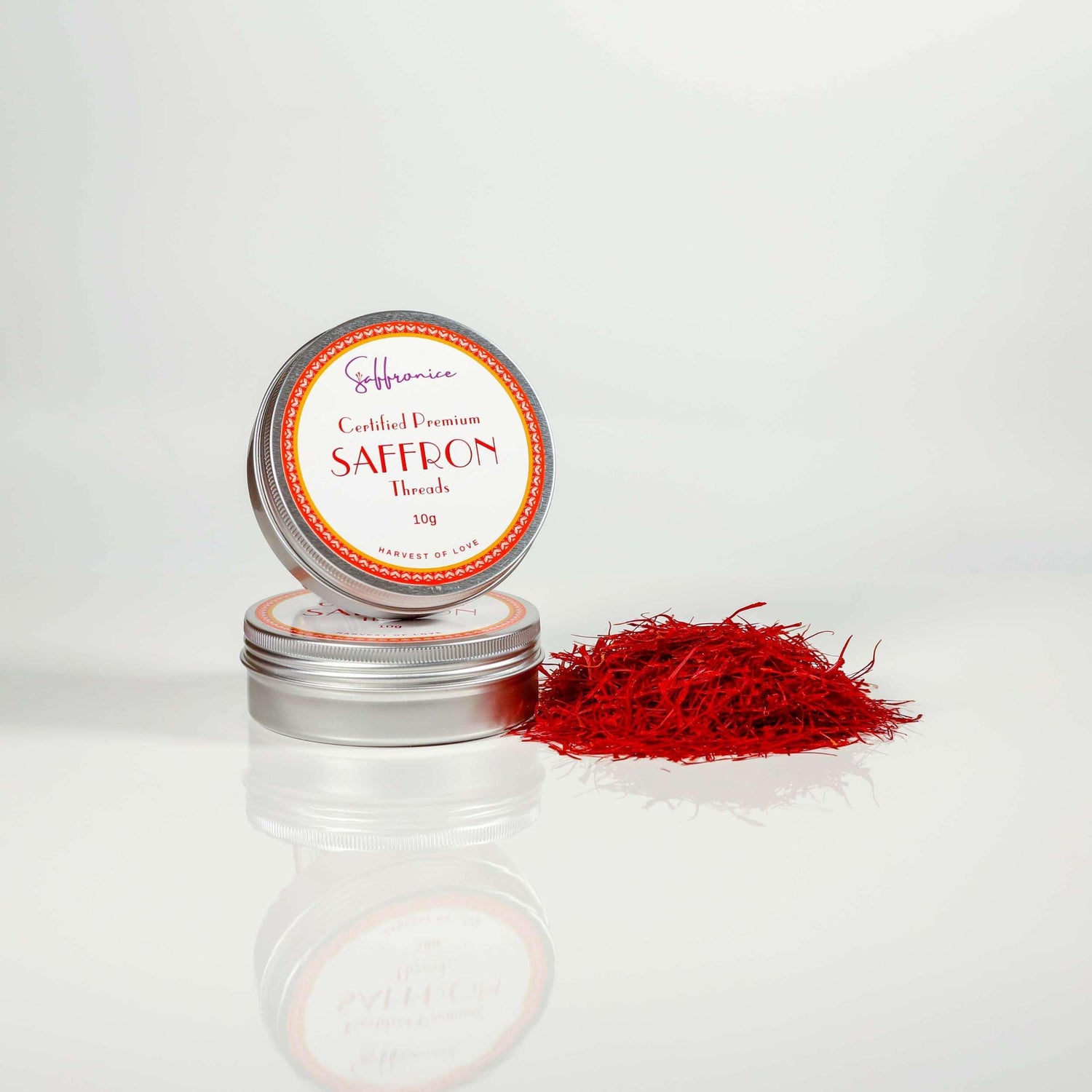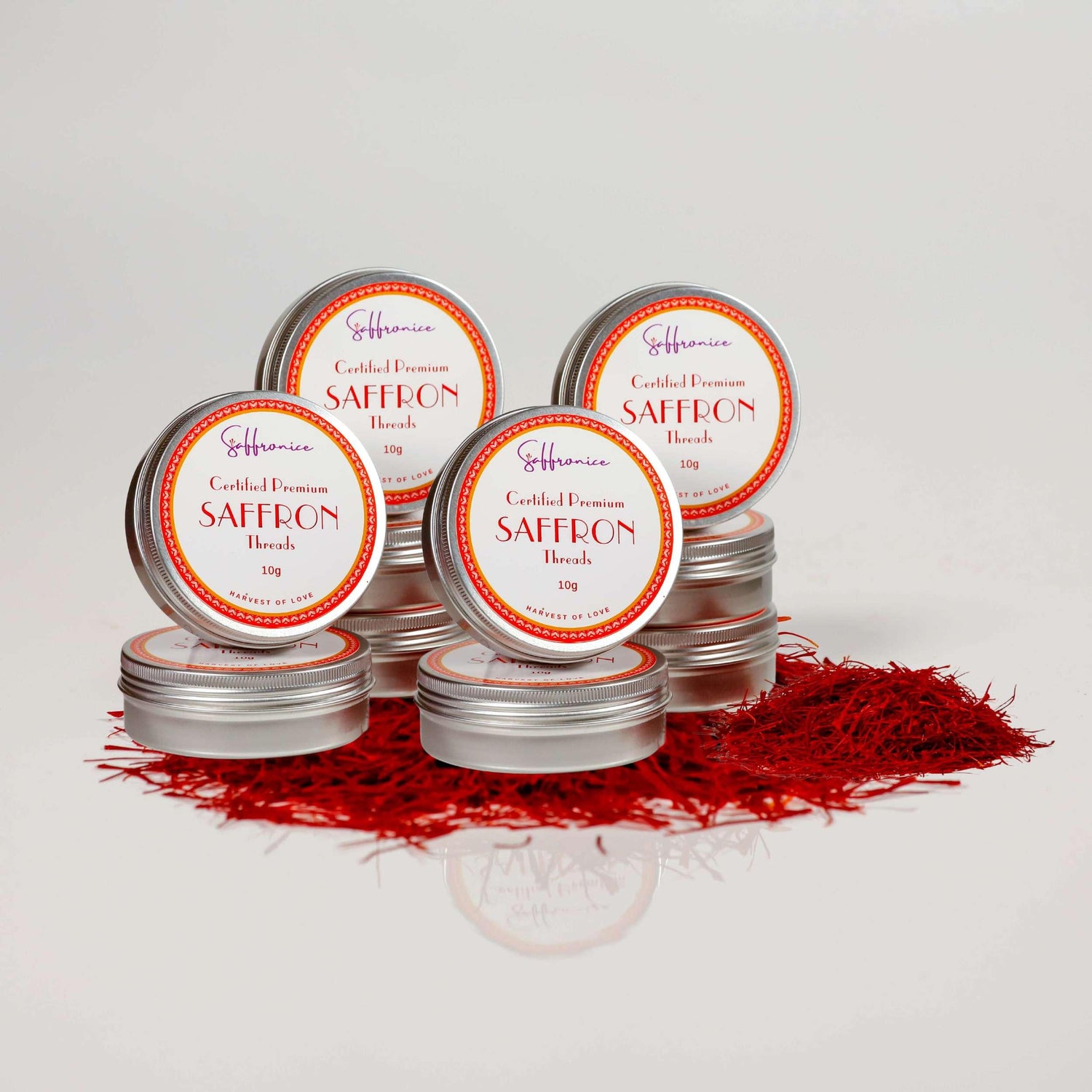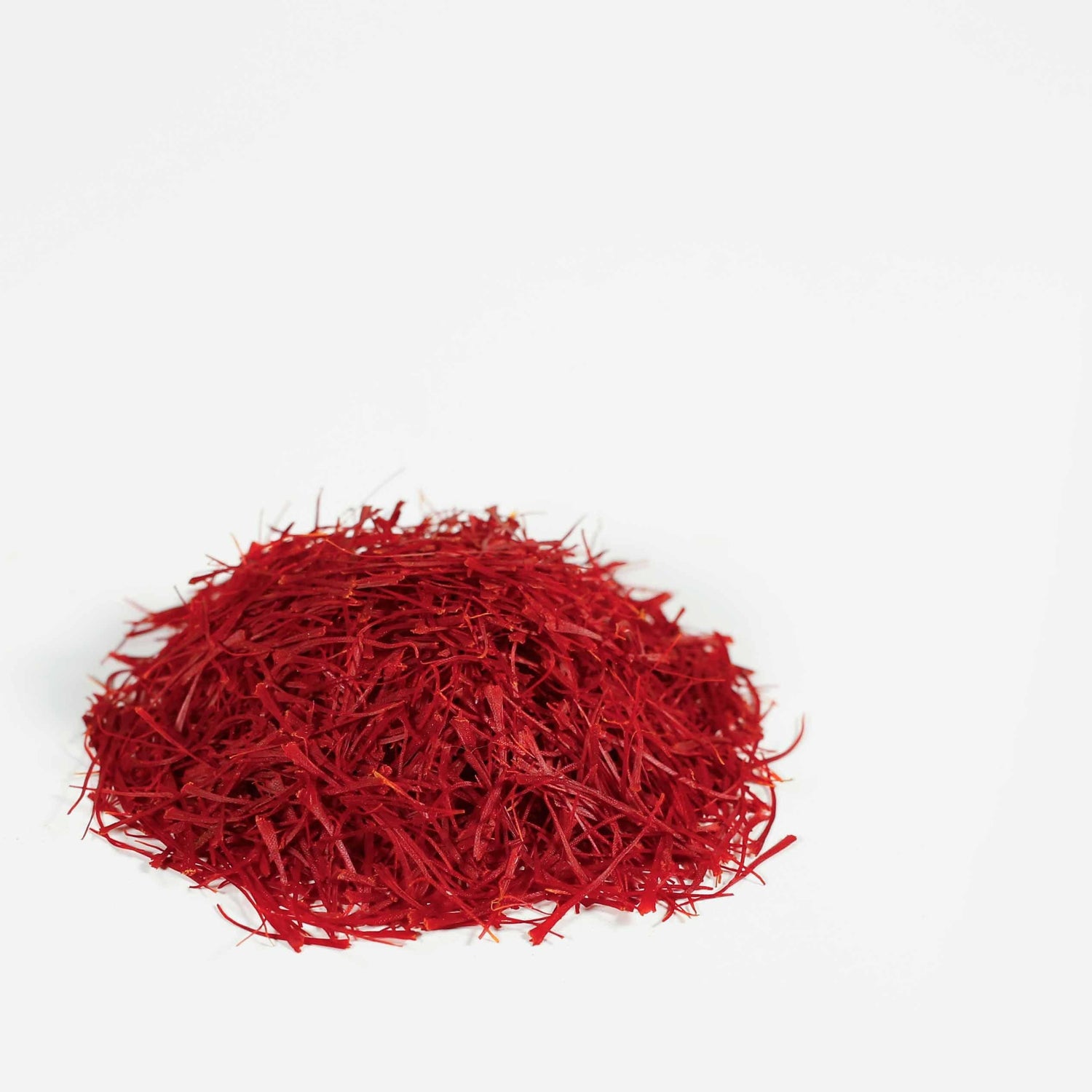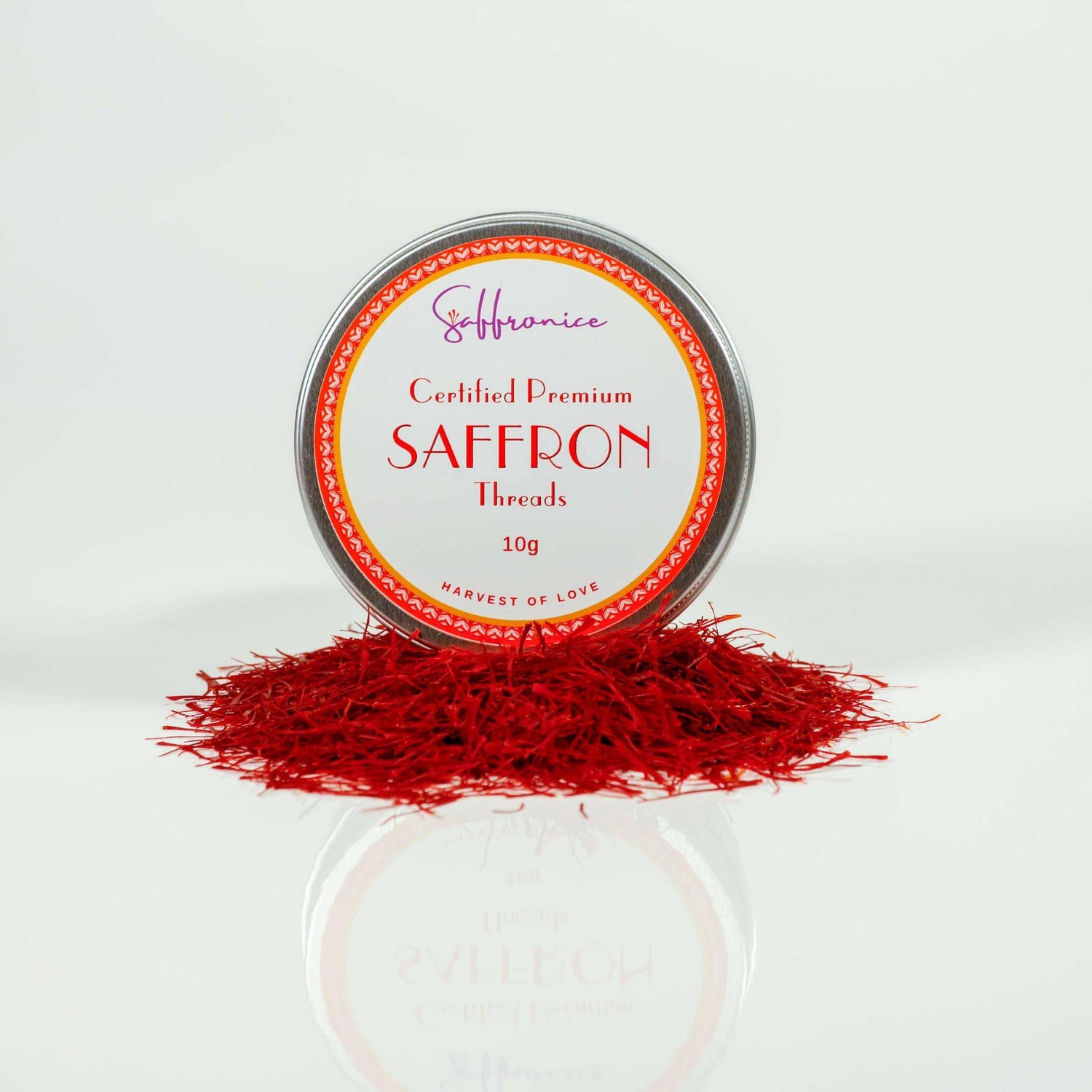1- How to discover the best Saffron in the world?
In this article, we will explore the key criteria for selecting high-quality saffron, delve into renowned saffron-producing regions, and discuss efforts towards sustainable saffron farming.
The allure of using premium saffron in culinary creations cannot be overstated. From its deep-red threads to its potent fragrance, quality saffron transforms ordinary recipes into exquisite culinary masterpieces.
Encourage your senses to embark on a journey as you discover the ultimate saffron brand that reigns supreme in terms of quality and taste. This exploration promises not only to enhance your understanding but also to enrich your culinary experiences.

For those looking to experience the luxury of cooking with saffron in a convenient form, Pure Saffron Powder offers handpicked and 100% natural saffron that enhances your dishes with exquisite aroma, flavour, and colour.
If you prefer the authentic essence of saffron in its traditional form, then Pure Saffron Threads sourced from family farms using traditional, NON-GMO methods might be the perfect choice for you. Handpicked and naturally dried, these threads ensure premium quality and flavor. They are available in various sizes with protective packaging to preserve their freshness.
Now that you have the option to choose between powdered or thread saffron depending on your preference and culinary needs, it's time to embark on the journey of discovering the ultimate saffron brand that will elevate your dishes to extraordinary levels.
2. The Essential Guide to Choosing the Finest Saffron
2.1 Understanding the Role of ISO 3632 Certification in Ensuring Saffron Purity
The ISO 3632 certification process plays a vital role in maintaining the quality of saffron available in the market. Developed by the International Organization for Standardization (ISO), this international standard carefully examines saffron using its chemical and physical properties, guaranteeing that only the purest and highest quality saffron is made accessible to consumers.
Key Aspects of ISO 3632 Certification:
- Purity Testing: The certification process involves strict testing to identify any adulteration or contamination. This ensures that the saffron is free from artificial colorants, foreign matter, and other impurities.
- Chemical Composition Analysis: Saffron is evaluated for its main chemical components—crocin, picrocrocin, and safranal. These compounds are crucial indicators of saffron's color, flavor, and aroma.
- Grading System: Based on the results of these tests, saffron is classified into various grades. The highest grade signifies exceptional quality with optimal levels of crocin (color), picrocrocin (taste), and safranal (aroma).
Why ISO 3632 Certification Matters:
- Consumer Confidence: ISO 3632 certified saffron provides consumers with confidence in the product's authenticity and quality. It acts as a reliable benchmark for comparing different saffron brands.
- Market Value: Certified saffron often commands a premium price in the market due to its guaranteed purity and quality standards.
- Global Recognition: This certification is internationally recognized, making it easier for consumers worldwide to identify high-quality saffron regardless of its origin.
Opting for saffron that bears the ISO 3632 certification can greatly enhance culinary creations by ensuring that only the finest spice is used in your dishes.
For those seeking to elevate their culinary adventures with premium saffron, consider exploring this option which adheres to stringent quality standards and offers a 10-gram saffron tin, meticulously harvested from the finest non-GMO saffron crocus bulbs.

2.2 The Colorful Key: Evaluating Saffron Based on Crocin Content
Crocin content is crucial in determining the quality of saffron. Crocin is a natural pigment found in saffron that gives it its bright red color. The amount of crocin in saffron directly affects both its color and potency, making it an important factor to consider when choosing saffron.
What to Look for When Assessing Crocin Content in Saffron:
- Color Intensity: The richness of color is a clear indicator of high-quality saffron. Saffron strands with a high crocin content will have a deep red color, often with a subtle shine.
- Flavor Enhancement: Crocin not only adds visual appeal but also enhances the taste of dishes. Its presence ensures that food achieves a vibrant and attractive color, leading to a more enjoyable dining experience.
- ISO 3632 Certification: This certification measures the levels of crocin as well as other important compounds like safranal and picrocrocin. Saffron that meets these standards guarantees optimal color and quality.
Example: Kashmiri and Iranian saffrons are known for their high levels of crocin, which contribute to their popularity in the market. These varieties are prized for their ability to impart a rich golden-yellow hue to dishes such as biryanis, paellas, and risottos.
Understanding the significance of crocin content helps us recognize why premium saffron stands out from lower-quality options. It showcases the unique qualities of this spice and its essential role in creating exceptional culinary delights.
2.3 Understanding the Aromatic Secrets: Measuring Safranal Levels in Saffron
Safranal, a volatile compound found in saffron, is responsible for its unique smell. It is this compound that distinguishes high-quality saffron from lower-grade options. The better the saffron, the higher its safranal concentration, resulting in a more intense and complex fragrance.
How Safranal Affects Saffron Quality
- Aroma: Safranal gives top-notch saffron its warm, sweet scent. Its presence indicates that the spice is fresh and potent.
- Flavor Enhancement: Besides its aroma, safranal also impacts the overall taste profile of saffron. It adds richness and intricacy, making dishes more flavorful.
- Quality Assurance: Saffron with elevated levels of safranal often meets the strict criteria outlined in ISO 3632 certification, making it a reliable marker of good quality.
The perfect combination of crocin content and safranal concentration defines premium saffron, providing both vibrant color and captivating aroma. These qualities are crucial for any culinary masterpiece that wants to fully utilize this exquisite spice's potential.
By knowing the importance of safranal, consumers can make better choices when purchasing saffron, ensuring they opt for varieties that offer unmatched flavor and aromatic strength.

3. Journey Through Revered Saffron Producing Regions
3.1 Kashmiri Saffron: The Prized Gem of India
Kashmiri saffron is one of the most highly regarded types of saffron globally. It is famous for its exceptional quality and distinct characteristics. This saffron comes from the beautiful valleys of Kashmir and is known for its deep red threads and strong fragrance, which contribute to its prestigious reputation.
Unique Floral Notes and Delicate Flavor Profile
- Floral Notes: Kashmiri saffron has a special combination of floral scents that adds a subtle yet intricate aroma to both sweet and savory dishes. This unique fragrance sets it apart from other types of saffron, providing a delightful experience for the senses.
- Flavor Profile: Recognized for its intense taste, Kashmiri saffron brings a slightly bitter but incredibly flavorful element to food. This depth of flavor makes it a top choice among chefs who want to enhance their culinary creations with an added touch of elegance.
Esteemed Reputation
Kashmiri saffron is highly valued in the market due to several reasons:
- High Crocin Content: The abundance of crocin in Kashmiri saffron results in a vibrant color that many desire. This natural pigment not only makes dishes visually appealing but also indicates the strength of the saffron.
- High Safranal Concentration: The elevated levels of safranal contribute to the powerful fragrance that defines this type of saffron. This volatile compound plays a crucial role in determining the overall quality of the spice.
- Organic Nature: Kashmiri saffron is often grown using traditional methods without relying on chemical pesticides or fertilizers. This dedication to organic farming practices ensures a purer product that appeals to health-conscious consumers.
Challenges and Sustainability Efforts
Despite its prestigious status, Kashmiri saffron faces significant challenges:
- Declining Production: Factors such as political unrest, droughts, and climate change have negatively impacted saffron farming in Kashmir. These issues pose threats to the livelihoods of local farming families who depend on this valuable crop.
- National Saffron Mission: To tackle these challenges, initiatives like the National Saffron Mission have been introduced. This mission aims to encourage sustainable farming practices, improve farmer incomes, and safeguard the heritage of Kashmiri saffron.
Kashmiri saffron continues to be a highly cherished spice, admired for its exceptional quality and distinctive features. Its fascinating history and cultural significance still enchant both experts and food enthusiasts today.
3.2 From Persia to Your Palate: The Rich Heritage of Iranian Saffron
The captivating charm of Iranian saffron comes from its rich history and unmatched quality. Known for its strong taste and powerful scent, chefs and food lovers worldwide have a special appreciation for Iranian saffron.
Key Characteristics of Iranian Saffron:
- Flavor Profile: Iranian saffron is famous for its deep, earthy taste with hints of honey and hay. This strong flavor makes it suitable for both sweet and savory dishes.
- Aroma: One of the standout qualities of Iranian saffron is its strong aroma. It contains a high amount of safranal, a volatile compound that gives saffron its unique smell, ensuring a distinct fragrance in every dish.
- Color: With its vibrant red threads and minimal presence of yellow or white parts, Iranian saffron adds a burst of intense color to recipes, indicating its high crocin content.
The exceptional quality of Iranian saffron can be attributed to Iran's specific climate and soil conditions. This precious spice, often known as "red gold," is carefully handpicked during harvest to ensure only the finest stigmas are chosen.
Chefs worldwide prefer Iranian saffron not just for its outstanding sensory qualities but also for its consistent reliability. Its impressive combination of flavor, aroma, and color makes it an essential ingredient in various cuisines.
Exploring the Persian roots behind this valuable spice unveils centuries of careful farming methods that continue to produce some of the best saffron in the world.
3.3 Sunny Fields and Scarlet Stigmas: The Golden Story of Spanish Saffron
Spanish saffron, especially from the La Mancha region, is highly regarded for its distinctive smell and strong taste. Known as the "red gold" of Spain, this type stands out with its sweet, earthy scent and a flavor that is both gentle and powerful.
Key features of Spanish saffron include:
- Color: Bright red threads, often with slight yellow ends.
- Aroma: Sweet and slightly honey-like, with an earthy undertone.
- Flavor: Delicate yet potent, ideal for infusing dishes with a rich depth.
Spanish saffron is widely used in traditional Spanish cooking. Its most famous application is in paella, where it adds a unique yellow color and a complex flavor that complements seafood, chicken, or rabbit. This saffron's special qualities make it a favorite among chefs who want to enhance their culinary creations.
The cultivation process in Spain involves carefully picking the fragile stigmas from crocus flowers grown in sunny fields. These are then meticulously dried to maintain their quality. Despite challenges such as fake products and inconsistent standards, genuine Spanish saffron remains a valued ingredient for its culinary excellence.
Exploring the wonderful features of regions like Kashmir, Iran, Afghanistan, Morocco, Greece, and Spain shows why these areas produce some of the most desired saffron varieties worldwide. Each region offers a unique flavor profile and aromatic experience, enhancing the global love for this exquisite spice.

4. Supporting Sustainable Saffron Farming for a Bright Future
4.1 The National Saffron Mission: Empowering Farmers, Preserving Heritage
The National Saffron Mission in India is a crucial effort to revive saffron farming and ensure it is done sustainably. It was created to tackle the decline in Kashmiri saffron production caused by political unrest, climate change, and other difficulties. The mission has two main goals: empowering farmers and safeguarding the long-standing tradition of saffron cultivation.
Key Objectives of the National Saffron Mission:
- Sustainable Cultivation Practices: Promoting environmentally friendly farming techniques to enhance soil health and increase saffron yield.
- Farmer Empowerment: Providing farmers with technical training, financial support, and access to advanced agricultural tools.
- Quality Assurance: Implementing stringent quality control measures to ensure that only the finest saffron reaches the market.
According to the Indian Government's Ministry of Agriculture, the National Saffron Mission has led to significant improvements in both production quantity and quality.
Role of IIKSTC (Indian Institute of Integrative Medicine)
A cornerstone of this mission is the establishment of the IIKSTC (Indian Institute of Integrative Medicine's High-Tech Spice Park) in Kashmir. This state-of-the-art facility offers comprehensive post-harvest management services, including:
- Stigma Separation: Mechanized processes ensuring precision and efficiency.
- Electrical/Vacuum Drying: Modern drying techniques that preserve the quality and potency of saffron.
- Grading & Packaging: Advanced systems for sorting and packaging saffron to meet international standards.
- Testing & E-Auctioning: Quality testing facilities coupled with an e-auction platform connecting farmers directly with buyers.
The IIKSTC also assists farmers in obtaining Geographical Indication (GI) tags for their produce. This certification not only authenticates the origin but also adds value by ensuring that consumers receive genuine Kashmiri saffron renowned for its superior quality.
Impact on Farmer Livelihoods
The National Saffron Mission has had a profound impact on improving farmer livelihoods by:
- Increasing Income: Higher yields and better market prices have boosted farmer incomes.
- Reducing Vulnerability: Diversification into sustainable practices has reduced dependency on traditional methods prone to environmental risks.
- Community Development: Enhanced infrastructure and support have led to overall community upliftment.
These focused efforts demonstrate India's dedication to preserving its saffron heritage while promoting sustainable farming practices. As we explore other aspects of sustainable saffron farming, these initiatives serve as a standard for similar endeavors around the world.
4.2 Leveraging Science for Safer Saffron: The Contributions of IIKSTC
The Indian Institute of Integrative Medicine (IIKSTC), part of the National Saffron Mission, is instrumental in addressing the challenges faced by saffron farmers and implementing quality control measures. Through various research projects, this institute is leading the way in preserving saffron's heritage and ensuring its sustainability.
Key Areas of Focus:
Advanced Post-Harvest Management
IIKSTC offers cutting-edge facilities for separating saffron stigmas, as well as for drying, grading, and packaging using electrical or vacuum methods. These steps are crucial in maintaining the superior quality of saffron at every stage of its journey from farm to market.
Quality Testing and Certification
To guarantee that saffron meets global standards, IIKSTC enforces strict testing procedures. One such certification is ISO 3632, which serves as a trusted indicator of saffron's purity and quality.
E-Auctioning and Marketing
With the goal of promoting transparency and expanding market opportunities for farmers, IIKSTC organizes e-auctions. This modern approach helps ensure fair prices for saffron of exceptional quality.
Geographical Indication (GI) Tagging
Thanks to IIKSTC's efforts, Kashmiri saffron has been granted a prestigious GI tag. This not only safeguards the authenticity of the product but also enhances its value by setting it apart from other varieties.
Research Efforts:
Climate Resilience
Ongoing studies are focused on developing saffron strains that can withstand challenging climates, such as prolonged dry spells and the effects of climate change.
Sustainable Practices
The institute actively promotes sustainable farming methods that aim to increase yield while preserving the environment's well-being.
These initiatives by IIKSTC highlight their dedication to using science as a tool for producing safer saffron. By combining traditional wisdom with modern advancements, they are paving the way towards a more promising future for saffron cultivation.

4.3 Safeguarding Authenticity: Geographical Indication (GI) for Kashmiri Saffron
Geographical Indication (GI) status serves as a critical measure to protect the unique identity and reputation of Kashmiri saffron against imitations. This designation ensures that only saffron cultivated in specific regions of Kashmir can bear the prestigious label, thereby safeguarding its legacy.
Key Benefits of GI Status:
- Protects Authenticity: The GI tag acts as a certification mark, affirming the origin and quality of Kashmiri saffron. This helps consumers distinguish genuine products from counterfeits.
- Market Recognition: Products with GI status often command higher prices due to their recognized quality and authenticity. This boosts the economic well-being of local farmers.
- Preserves Heritage: Geographical Indication safeguards traditional farming practices and promotes sustainable agriculture within the region, ensuring the long-term viability of saffron cultivation.
National Saffron Mission's Role:
The National Saffron Mission, along with institutions like the Indian Institute of Integrative Medicine's High-Tech Spice Park (IIKSTC), has played a pivotal role in obtaining the GI tag for Kashmiri saffron. These initiatives enhance quality control measures, provide advanced post-harvest management facilities, and support marketing efforts—ensuring that the heritage and high standards of Kashmiri saffron are upheld.
5. Where to Buy the Excellence: Source Guide for Premium Saffron Threads and Powder
Finding a reliable source for buying saffron can be daunting, but it’s crucial for ensuring the quality and authenticity of this precious spice. Here are some trusted avenues where you can purchase high-quality saffron with confidence.
5.1 Seeking Vibrant Red Threads and Aroma
When buying saffron, pay close attention to its appearance and fragrance. Here are specific tips to guide you:
- Color: Look for threads that are vivid red. High-quality saffron should have a deep, rich red hue without any yellow or white parts, which indicate inferior quality.
- Aroma: Saffron should have a strong aroma that is unmistakable and potent. The fragrance should be slightly sweet with a hint of metallic notes.
- Threads: Opt for whole threads over powdered saffron if possible. Whole threads are less likely to be adulterated and provide better control over the dosage in culinary applications.
To ensure you get the best quality, consider these reputable saffron producers:
Reputable Sources for Buying Saffron
- Saffron StoreSpecializes in premium Persian saffron from Iran
- Products are ISO 3632 certified
- Offers both threads and powder
- Kashmir Online StoreDirectly sources from Kashmiri farmers
- Provides detailed information on Geographical Indication (GI) status
- Known for Mongra and Lacha varieties of Kashmiri saffron
- La Mancha Saffron ShopFeatures Spanish saffron with intense flavor profiles
- Assures quality through stringent checks
- Ideal for those seeking authentic La Mancha saffron
- Amazon (Certified Sellers)Platforms like Amazon host several certified sellers
- Look for sellers with high ratings and positive reviews
- Check for ISO certification and product descriptions that detail origin
By following these guidelines and buying from trusted suppliers, you can experience the unmatched taste, fragrance, and color that only the best saffron can provide.

6. Embracing Culinary Excellence with the Finest Saffron
6.1 Harnessing the Power of Pure Threads: Tips for Using Saffron in Cooking
Cooking with saffron opens a world of rich flavors and vibrant colors, elevating any dish to gourmet status. Mastery in using saffron in cooking requires attention to detail and an understanding of its unique properties.
Preparation Techniques
Before incorporating saffron into your recipes, proper preparation is essential:
- Toasting: Lightly toast the saffron threads in a dry skillet over low heat for a few seconds until they become crisp. This process enhances their aroma and flavor.
- Grinding: Use a mortar and pestle to grind the toasted threads into a fine powder. This allows for even distribution and maximum flavor extraction.
- Soaking: Soak the ground saffron in warm water, milk, or broth for at least 20-30 minutes before adding it to your dish. This releases the color and aroma fully.
Dosage
The amount of saffron used can greatly impact a dish:
- Subtle Flavor: For a mild hint of saffron, use approximately 5-10 threads per recipe serving.
- Bold Flavor: For a more pronounced taste, increase to 15-20 threads. Be cautious as too much saffron can overpower other ingredients.
Applications in Various Cuisines
Saffron's versatility makes it suitable for a variety of culinary applications:
Rice Dishes
- Paella: Add soaked saffron during the final stages of cooking to infuse the rice with its exquisite aroma and deep golden hue.
- Risotto: Incorporate saffron early in the cooking process for an even distribution of flavor.
Desserts
- Saffron Ice Cream: Blend saffron-infused milk with your ice cream base for a luxurious treat.
- Saffron-infused Syrup: Drizzle over cakes or pastries to add an exotic touch.
Beverages
- Saffron Tea: Steep a few threads in hot water along with your favorite tea leaves.
- Golden Milk: Mix saffron with warm milk and honey for a comforting drink.
Enhancing Other Spices
Combining saffron with other spices can create complex flavor profiles:
- Pair with cardamom and cinnamon in sweet dishes like kheer or rice pudding.
- Combine with cumin and coriander for savory stews and soups.
Using these techniques ensures you harness the full potential of pure saffron threads, bringing unparalleled depth and richness to your culinary creations. The journey through diverse cuisines highlights how this prized spice transforms ordinary recipes into extraordinary dishes.
6.2 Exploring Non-Culinary Uses for Saffron's Aromatic Qualities
Saffron's rich aroma is not just limited to cooking; it also has a special place in other areas. Here are some examples:
6.2.1 Perfumery
In the world of high-end perfumes, saffron is highly valued for its captivating scent. It is often used alongside floral and spicy notes to create a luxurious and exotic fragrance.
6.2.2 Tea Blends
Saffron-infused teas have become increasingly popular due to their soothing properties and unique taste. Whether added to herbal or black teas, saffron brings a delicate aroma that elevates the tea-drinking experience. It may also have potential health benefits such as improving mood and reducing anxiety.
6.2.3 Traditional Uses
Throughout history, saffron has played a role in various cultural traditions and practices, including traditional medicine. Its essence is believed to have calming effects, making it a common ingredient in aromatherapy treatments aimed at promoting relaxation and emotional well-being.
6.2.4 Cosmetic Applications
The use of saffron in skincare products is on the rise, thanks to its anti-inflammatory and antioxidant properties. Creams, serums, and masks infused with saffron extracts are used to improve skin tone and texture.
By exploring these non-culinary uses of saffron, enthusiasts can discover its versatile benefits in enhancing sensory experiences and overall well-being across different areas of life.

7. The Best Saffron Brand: Our Recommendation
Introducing our premium saffron, a benchmark in quality and flavor. Our brand offers saffron threads and powder that are meticulously sourced from the finest fields known for their rich, vibrant saffron.
Key Features:
- Exceptional Quality: Each saffron strand is handpicked with utmost care, ensuring every bottle delivers an unrivaled sensory experience.
- Sourced Ingredients: We partner with reputable farmers who adhere to sustainable farming practices, guaranteeing pure and potent saffron.
- Industry Standards: Our saffron meets the highest industry standards, including ISO 3632 certification, ensuring top-tier purity and quality.
Our commitment to excellence makes our brand stand out as the best saffron brand in the market. Whether you are a culinary enthusiast or a professional chef, our saffron promises to elevate your dishes with its deep color, robust aroma, and exquisite taste.
Experience the Epitome of Saffron Luxury
Indulge in the ultimate saffron experience by exploring our recommended brand. Whether enhancing your favorite recipes or savoring a cup of saffron-infused tea, our premium pure saffron threads and powder promise to captivate your taste buds. The unmatched quality of our saffron elevates culinary creations to new heights of excellence.
Why Choose Our Recommended Saffron Brand?
- Unparalleled Quality: Hand-harvested with meticulous care, ensuring each thread embodies the essence of luxury.
- ISO 3632 Certified: Guaranteeing purity and superior grading.
- Rich Aroma and Flavor: High safranal concentration delivers an intoxicating fragrance while crocin content imparts vibrant color and robust taste.
- Versatility in Use: Ideal for a wide range of dishes, from gourmet meals to simple home-cooked recipes.
Elevate Your Culinary Creations
Imagine the delight of infusing your rice dishes, soups, or desserts with the golden hues and rich flavors of top-tier saffron. Whether you are a professional chef or an enthusiastic home cook, incorporating high-quality saffron into your culinary repertoire transforms ordinary meals into extraordinary experiences.
Savor the Tradition
A cup of saffron tea offers more than just a beverage; it’s an immersion into centuries-old traditions and wellness benefits. Brewed with our premium threads, each sip delivers a soothing and aromatic journey that rejuvenates the senses.
Explore our collection today and discover why our brand reigns supreme in purity and taste. Buy saffron that sets a new standard for excellence and authenticity.

FAQs (Frequently Asked Questions)
What is the significance of using the best saffron in culinary creations?
Using the best saffron enhances the flavor and aroma of dishes, elevating the overall culinary experience. It adds a unique depth of taste and a vibrant color to various recipes, making it an essential ingredient in many cuisines.
What key criteria will be explored in this article for selecting high-quality saffron?
This article will delve into renowned saffron producing regions, discuss the efforts towards sustainable saffron farming, and explore the ultimate saffron brand that reigns supreme in terms of quality and taste.
How does ISO 3632 certification ensure saffron purity?
ISO 3632 certification is a reliable indicator of saffron quality as it involves rigorous testing and grading based on parameters such as crocin content and safranal concentration, ensuring that only pure and high-quality saffron receives certification.
What sets premium saffron apart from lower-quality varieties based on crocin content?
Premium saffron is distinguished by its high crocin content, which imparts a vibrant color to dishes. The intensity of the color is a key indicator of the quality and purity of the saffron.
What is the role of safranal in determining the overall quality of saffron?
Safranal is a volatile compound responsible for saffron's distinctive aroma. Its presence influences the overall quality and flavor-enhancing properties of the spice, making it an important factor in assessing saffron quality.
What are some renowned saffron producing regions mentioned in this article?
The article explores revered saffron producing regions such as Kashmir (India), Iran, Spain, Afghanistan, Morocco, and Greece, shedding light on their unique characteristics and flavors.


